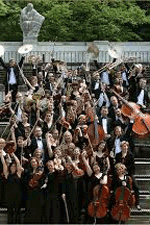> [Archived] Chronicles

Discovering the Polish Youth Orchestra
The summer season offered by Lanto Communication and The 'Serafim Antropov' Friends of Music Foundation brought a new guest to the Athenaeum, the 'Sinfonia Juventus' Orchestra from Poland, which opened the series of foreign youth ensembles that visit our country, as a part of the collaboration between the Romanian Youth Orchestra and its founder, cellist Marin Cazacu, in the International Association of Youth Orchestras. Thus, we discovered the only such orchestra that is fully financed by the state - which, we must admit, is worthy of praise and it should offer us food for thought -, made up of instrumentalists under 30 years old; I remarked the dense sound, great homogeneity and quality of the wind or string instrumentalists, the correctness and accuracy which they showed when solving the mosaic-like scores included in the programme, which were chosen by conductor Tadeusz Wojciechowski, possibly with a view to showing accessible ones, closer to dance rhythms. Naturally, we listened to pages by famous Polish composers, such as Moniuszko (fragments from the Halka opera) or Lutoslawski (Little Suite); the latter was surprising in his relation to benchmarks reminiscent of his equally renowned contemporaries, like Stravinsky or Bartok, in an agreeable and very rhythmic work. We also listened to the overture to the operetta Light Cavalry by Suppé, Zigeunerweisen by Sarasate - the concertmaster Jan Kutkowski was the soloist who covered the rich composition with honesty and… discretion - as well as Liszt's Hungarian Rhapsody no. 2 and a Czardas from the Hary Janos suite by Kodaly. Why did he choose such a structure, on what 'areal' criteria? One should ask the conductor…
Remaining to the stand almost all the time, approaching the compositions in a 'compact' order, without the usual break, the ensemble responded promptly to the conductor's concept, a surprisingly inflexible one, which brought together - in expression and manner of playing - very different compositions in style and spirit; few colours, a lot of rhythmic sequences highlighted in an almost military way, others that were faded, dull, with no variety or… imagination, which generated the lack of lustre and magnitude, although there were quite a few strong fragments… The wind and violin solos were great, the entire evolution of the orchestra was praiseworthy, but I have tried to imagine it led by another conductor who, by overcoming (or giving up) accurate timekeeping, would have required more nuances, a better fluency of discourse, as well as sensitivity or the air specific to the excellent opuses they approached. There were two encores… that sounded the same, but after one and a half hours of music, I felt that all ten moments they had chosen sounded terribly… alike, with the audience feeling the need for a real variety of moods, sounds and expressivity. It was, therefore, a very neat concert, with an attractive repertoire, but something was missing… Perhaps a more temperamental and relaxed conductor…
Translated by Irina Borțoi and Elena Daniela Radu
MTTLC, The University of Bucharest














